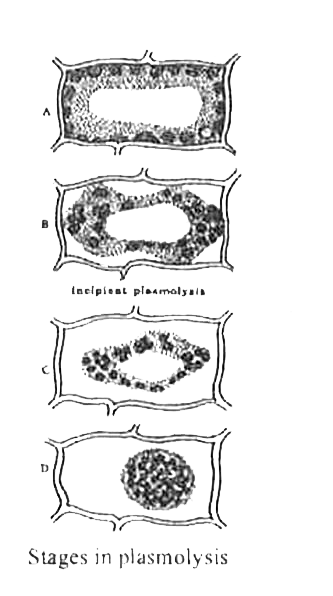With the help of well-labelled diagrams, describe the process of plasmolysis in plants, giving appropriate examples.Solution in Kannada
The shrinkage of protoplasm of a cell due to loss of water by exosmosis is called plasmolysis and the cell is said to be plasmolysed. As a result the cell becomes flaccid. Suppose a cell is surrounded by a solution which is more concentrated (hypertonic) than the cell sap, water molecules diffuse out of the cell through the membrane (exosmosis). The solution of higher concentration than that of the cell sap is called a hypertonic solution. As a result the cell sap loses water and the cell becomes flaccid. The protoplasm shrinks. The extent of shrinkage of the cytoplasm depends upon the concentration of the surrounding solution. If is slightly more concentrated than the cell sap, incipient plasmolysis is observed. If the cell in incipient plasmolysis is placed in hypertonic solution for some more time, it enters into evident plasmolysis and further into final plasmolysis.

Topper's Solved these Questions
Similar Questions
Briefly describe water potential. What are the factors affecting it?
View SolutionExplain the stucture of the Dicot leaf with a labelled diagram.
View Solution(a) With the help of well-labelled diagrams, describe the process of plasmolysis in plants, giving appropriate examples. (b) Explain what will happen to a plant cell if it is kept in a solution having higher water potential.
View SolutionWith the help of well labelled diagrams describe the structure of a typically bacterial cell.
View SolutionWith the help of well labelled diagram describe the internal structure of human heart .
View Solution(a) With the help of well-labelled diagrams, describe the process of plasmolysis in plants, giving appropriate examples.
(b) Explain what will happen to a plant cell if it is kept in a solution having higher water potential.
View SolutionGive an overview of the plasmolysis method of plants with appropriate examples and marked diagrams.
View Solution(a) With the help of well-labelled diagrams, describe the process of plasmolysis in plants, giving appropriate examples. (b) Explain what will happen to a plant cell if it is kept in a solution having higher water potential.
View Solution(a) With the help of well-labelled diagrams, describe the process of plasmolysis in plants, giving appropriate examples. (b) Explain what will happen to a plant cell if it is kept in a solution having higher water potential.
View Solution(a) With the help of well-labelled diagrams, describe the process of plasmolysis in plants, giving appropriate examples. (b) Explain what will happen to a plant cell if it is kept in a solution having higher water potential.
View SolutionDescribe the process/ mechanism of plant cell plasmolysis with example and labelled diagram.
View SolutionWith the help of a labelled diagram, describe double fertilization in plants.
View SolutionDescribe plant cell wall with well labelled diagram.
View SolutionDescribe the process of filtration with the help of a well-labelled diagram.
View SolutionDescribe the process of fertilization with a well-labelled diagram.
View SolutionDescribe the structure of a nucleosome with the help of a well-labelled diagram.
View Solution
